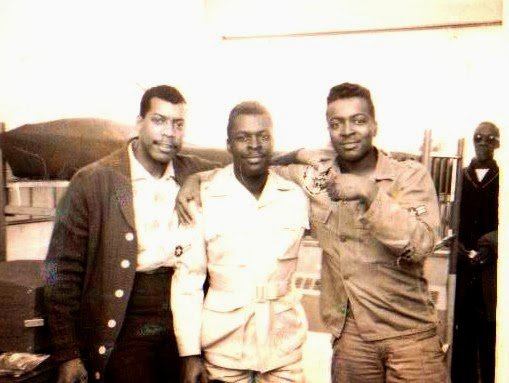James Montgomery: Spray-painting military aircraft is not good for the health.
Mr. Montgomery, on the right.
Found out some interesting things about the kind of chemicals James Montgomery was exposed to while serving as an aircraft spray painter served in the United States Air Force from 1960 to 1963 at Minot, Glasgow and Richards Gebaur Air Force bases.
I found hard evidence that carcinogenic compounds were used at the three Air Force bases where Mr. Montgomery worked as an aircraft painter.
Final Environmental Baseline Survey, Supporting the Privatization of Military Family Housing at Minot Air Force Base, North Dakota, Air Force Center For Engineering and the Environment, March 2009. Excerpts of this environmental study of the Minot Air Force Base state that the 5th Fighter Interceptor Squadron was transferred to the Minot AFB in 1960. In 1984, an environmental restoration program initiated at the base identified 11 sites where “contaminates in the soil and water of these areas included fuels, waste solvents, and inorganics.”
The complete report is located here.
Site Health and Safety Plan, Evaluation of Long Term Monitoring, Former Glasgow Air Force Base, prepared for U.S. Army Corps of Engineers by CDM Federal Programs Corporation. February 18, 2011. Excerpts of this study show that the Glasgow AFB was developed between 1955 and 1960. The report indicates that chlorinated solvents were found at the site and which necessitated long-term monitoring.
EPA Superfund Record of Decision: Richards Gebaur Air Force Base. September 23, 2004. Excerpts of this report summarizes remediation work at the Superfund site located at the Richards Gebaur Air Force Base. At the base, several sites were discovered where the soil was contaminated with petroleum hydrocarbons “considered the result of historical spills and leaks that occurred during the routine storage and handling of petroleum products.” The groundwater underneath six sites on the base was found to be contaminated with “volatile organic compounds (VOC), including trichlorethene (TCE), cis-1,2-dichloroethene (DCE), and vinyl chloride. It is likely that groundwater contamination originates from the past storage or handling of solvents …” One of the sites was the maintenance shop, which between in the 1960s was used to keep “bulk supplies of degreasers, solvents, oils and other common workshop materials.” Benezene, vinyl chloride, dichloroethene and trichloroethene. The full report can be found here.
There studies that show in that the Air Force -- the entire aircraft industry for that matter -- what using all manner of carcinogenic epoxies to coat aircraft.
Here's hoping that the VA will decide its breathing in paint fumes for three years *might* be connected with cancer.
If you know anything that might be helpful to Mr. Montgomery's case, please don't hesitate to contact me through this site.


